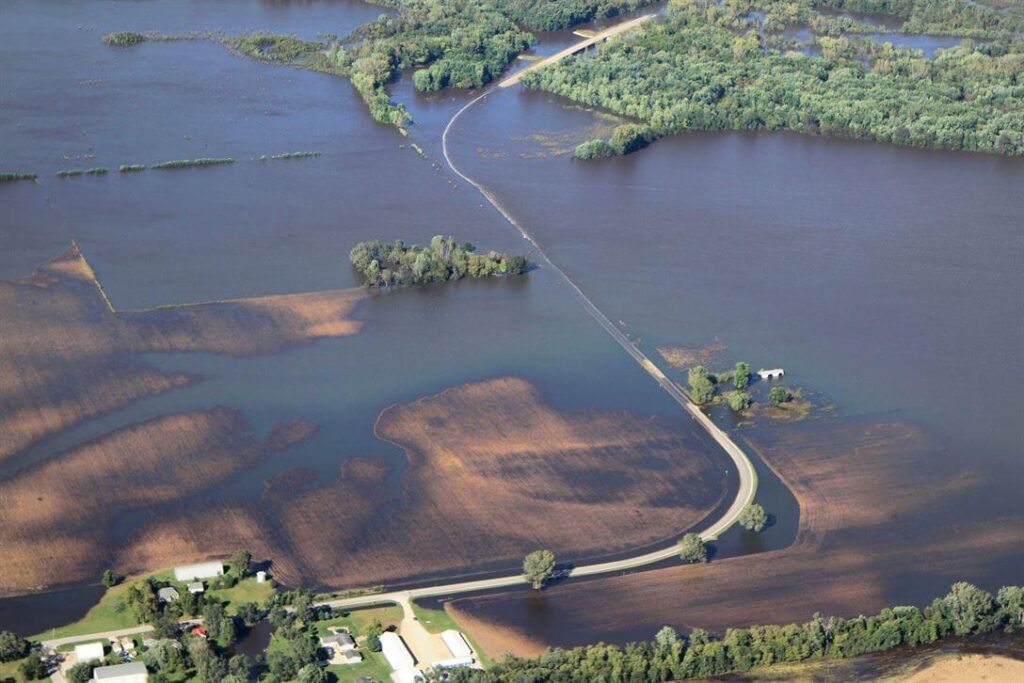Congress is MOVING FORWARD on resilient infrastructure
After months of debate and discussion, on July 1 the U.S. House of Representatives passed H.R. 2, the Moving Forward Act, a $1.2 trillion comprehensive infrastructure package that included several key provisions to enhance the resilience of our communities. The Act includes large-scale investments in America’s highways, water infrastructure, and affordable housing, as well as substantial funding for programs that increase resilience and protect against natural hazards and disasters. While the Moving Forward Act is not expected to be considered by the Senate before the end of the year, the House-passed legislation offers positive solutions to strengthen the country’s infrastructure against rising seas, stronger storms, and more frequent flooding.
In this post, we break down the resilience provisions in the Moving Forward Act, highlight key amendments, and discuss what’s next for infrastructure legislation.
Why did the House adopt a sweeping infrastructure bill right now?
Passing an infrastructure package to rebuild and revitalize the country’s aging infrastructure, stimulate economic development, and create jobs has long been on the agenda on Capitol Hill.
Though the Moving Forward Act is not likely to become law, the COVID-19 crisis and its resulting economic hardship have brought a renewed focus to infrastructure legislation from House leadership, as a way to create jobs and bolster the economy.
Additionally, a large component of any infrastructure proposal is expected to include spending on surface transportation to upgrade roads, bridges, and public transit systems. This year, discussions around surface transportation are timely—the 2015 Fixing America’s Surface Transportation (FAST) Act, which authorizes federal surface transportation programs, is set to expire on September 30. To continue to invest in surface transportation, Congress must either pass an extension of the FAST Act authorizations or a new highway bill to replace the legislation. In February 2020, we reported on the FAST Act and Congressional surface transportation priorities, as well as the initial “Moving Forward” framework released by House Democrats.
How does the Moving Forward Act enhance flood resilience?
While the Moving Forward Act is a comprehensive infrastructure bill, the bulk of the bill directs funding toward America’s surface transportation infrastructure. Notably, the Moving Forward Act folds in the text of the INVEST in America Act, the recent surface transportation bill by the House Committee on Transportation & Infrastructure. The Moving Forward Act incorporates funding priorities from the INVEST Act, including $494 billion over five years for the country’s surface transportation infrastructure, $319 billion of which will be used for highway upgrades.
The Moving Forward Act also includes several provisions related to the resilience of surface transportation assets. In particular, the legislation would:
- Establish a $6.25 billion pre-disaster mitigation program to fund resilience projects for highway and transit. The program would fund a range of projects, from protecting natural infrastructure and adding protective features to relocating evacuation routes and other transportation infrastructure threatened by extreme weather. To be eligible for funding through the program, projects would need to be identified in vulnerability assessments conducted by States and Metropolitan Planning Organizations (MPOs).
- Require MPO and State-prepared long-range transportation plans to consider resilience and hazard mitigation in planning efforts and include a vulnerability assessment of critical transportation assets, evacuation routes, and facilities repeatedly damaged by disasters.
- Authorize a Pre-Disaster Hazard Mitigation Pilot Program for federal-aid highways, funded through the Highway Trust Fund. This program would focus on cost-effective hazard mitigation projects, including flood resilience projects and road relocation projects, that reduce the risk of, or increase resilience to, future damage from natural disasters.
- Allow resilience features to be eligible projects under two key highway funding programs, the National Highway Performance Program and the highway Emergency Relief fund.
In addition to surface transportation provisions, the Moving Forward Act would significantly invest in other sectors, including $65 billion for water infrastructure, $100 billion for affordable housing, and $100 billion for broadband.
The Moving Forward Act would also create several new grant and loan programs to fund new resilience projects. To this end, the legislation would:
- Allow states to establish hazard mitigation revolving loan funds under the Federal Emergency Management Agency (FEMA) for resilience projects that reduce the risk and costs of natural disasters. Loans would be available to eligible local governments.
- Create a $3 billion coastal restoration fund to help communities invest in coastal restoration projects that address sea level rise, increased coastal flooding, and more frequent storms.
- Authorize $50 million per year for a new grant program for living shoreline projects through the National Oceanic and Atmospheric Administration (NOAA).
- Authorize $1 billion to municipalities to carry out watershed and resiliency projects and expand grant eligibility for public wastewater utilities to assess and address risk posed by disasters and sea level rise.
Amendments to the Moving Forward Act that advance resilience and equity
House members submitted over 300 amendments to the Moving Forward Act, some of which advanced resilience. Several of our Federal Champions submitted these resilience amendments, included in the final bill, which advance pre-disaster mitigation efforts, ensure healthcare facilities are prepared for flooding disasters and authorize a federal study into the equitable implementation of FEMA programs. Below are some of the amendments
- As referenced above, the Moving Forward Act would establish a Pre-Disaster Hazard Mitigation Pilot Program for federal roadways—Rep. Garret Graves (R-LA) championed this effort and included it as part of the legislation during the House Transportation & Infrastructure Committee’s markup in June.
- Rep. Joe Cunningham (D-SC) proposed two amendments during floor consideration of the legislation. Both amendments prioritize disaster preparedness and flood mitigation projects that protect critical health care facilities. One of the amendments requires MPOs to review the accessibility of health care facilities during emergency situations to better plan for the impacts of disasters.
- Rep. Joe Morelle’s (D-NY) amendment authorizes a Government Accountability Office study on the accessibility of FEMA’s Public Assistance, Individual Assistance, and other relevant flood disaster assistance programs, with a focus on identifying barriers to access based on race, ethnicity, language, and income level. Our recent Turning the Tide series highlights the need to examine the equity dimensions of federal disaster programs.
Now that the Moving Forward Act has passed the House, what’s next?
The American Flood Coalition will continue monitoring the progress of the Moving Forward Act as the Senate considers policy proposals to reauthorize federal surface transportation programs before September 30. The Senate is not expected to take up the House-passed Moving Forward Act. That said, the Moving Forward Act will serve as a marker for future negotiations between the two chambers on any long-term surface reauthorization. Additionally, the legislation reveals some priorities of House Democratic leadership and what’s next should Congress pass a short-term extension of existing programs this fall, which would push any debate on long-term reauthorization into 2021 and a new Congress.
The Senate has worked on its own long-term surface transportation legislation this past year. Last summer, the Senate Environment and Public Works Committee approved a bill, S.2302 “America’s Transportation Infrastructure Act,” that also contained significant provisions to increase the resilience of surface transportation infrastructure. However, momentum on that legislation has slowed in recent months.
As mentioned above, Congress must either extend the 2015 FAST Act or pass surface transportation legislation to replace the law by September 30, 2020. We will closely watch any developments on surface transportation or infrastructure legislation and update our members on provisions that increase the resilience of infrastructure and expand funding for flood mitigation.






